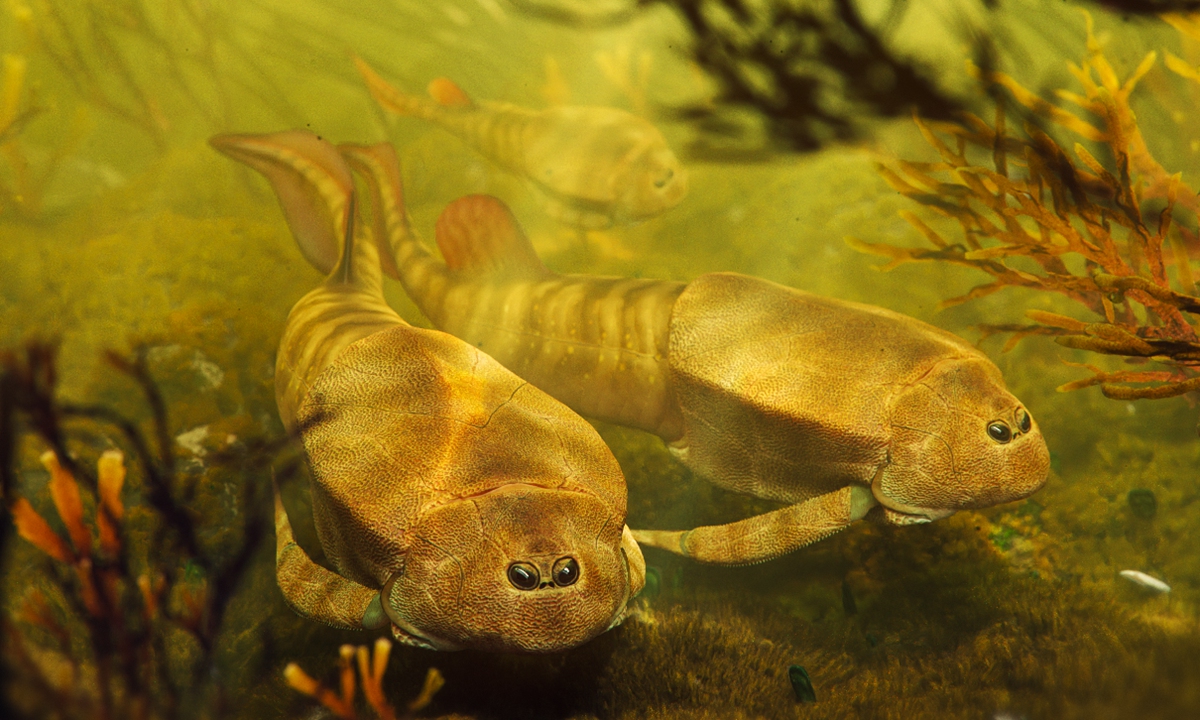
Paleoecological restoration of Bothriolepiszhujiangyuanensissp. nov. Photo: NICE PaleoVice Lab,MK socks ivpp
A new paleofish species fossil,
Bothriolepiszhujiangyuanensis, has been discovered in Qujing, Southwest China's Yunnan Province, the Chinese Academy of Sciences announced on Thursday. This is the first time a fish fossil has been found at the source of the Pearl River, marking the discovery of a new species of
Bothriolepisin nearly 50 years in China, Xian Zumin, a member of the excavation team from Yunnan University, told the Global Times.
"The research clarifies the phylogenetic relationships among
Bothriolepisspecies, which has deepened people's understanding of the early evolution of this genus," Xian noted. "It offers insights into the potential biogeographical connection between southern China and Kazakhstan plates around 390 million years ago."
According to Xian, this new species of
Bothriolepis is characterized by a broad postpineal plate with a straight anterior margin, a premedian plate that is wider than long, and a weakly developed dorsal median ridge on the trunk shield.
Bothriolepiszhujiangyuanensisis a highly specialized group. Its orbits are positioned dorsally, and its body is encased in a hard, long, box-shaped dermal skeleton, while its pectoral appendages are wrapped in small, segmented bony plates. These characteristics suggest that it likely led a bottom-dwelling lifestyle, according to the Institute of Vertebrate Paleontology and Paleoanthropology of the Chinese Academy of Sciences.
"
Bothriolepisis a genus with a wide global distribution, having nearly 100 species, yet the phylogenetic relationships within the genus remain contentious," she said. "Therefore, conducting in-depth morphological studies of this group is key to resolving phylogenetic issues within
Bothriolepisand further exploring related taxonomic, paleobiogeographical, and other issues."
According to a document disclosed by Xian in 2019, a large number of scattered ancient fish fossils were discovered along the trail leading to the summit of Maxiong Mountain in Yunnan Province. After conducting a detailed geological survey of the strata near the Pearl River's source and its surrounding areas, a significant number of Middle Devonian fish fossils were discovered, including
Bothriolepiszhujiangyuanensis, which was named after the region (Pearl River source). However, this is not the first discovery of a
Bothriolepisspecies in the Pearl River basin.
Since
Bothriolepissinensis (Chinese paleofish fish) was first established in 1940 based on an internal mold of an anterior median dorsal plate found in Central China's Hunan Province, China has conducted nearly a century of research on
Bothriolepisspecies. Notably,
Bothriolepissinensis is also the first Paleozoic fish species to be named by Chinese scholars.
According to researchers, aside from
Bothriolepiszhujiangyuanensis, all
Bothriolepisspecies from China share two common derived features: "the width of orbital fenestra greater than 1/3 of the skull roof" and "an anterior margin concave shape of obtected nuchal area."
Bothriolepiszhujiangyuanensis, however, forms a sister group with
B.babichevifrom Kazakhstan due to its shared derived trait of "elongated proximal segments in the pectoral appendage."
"Our study further confirms the biogeographical exchange between the southern China and Kazakhstan plates during the Middle Devonian period, which was 393 million to 382 million years ago," Xian noted.
The discover confirms, within a phylogenetic framework, the close relationship between different taxa on the two plates, providing further evidence of biogeographical exchange between the southern China and Kazakhstan plates during the Middle Devonian period.
Xian told the Global Times that they have discovered many
Bothriolepisfossils in the Pearl River Source Scenic Area. Currently, only
Bothriolepiszhujiangyuanensishas been described, but they will continue their research and release more information about the remaining specimens in the future.

